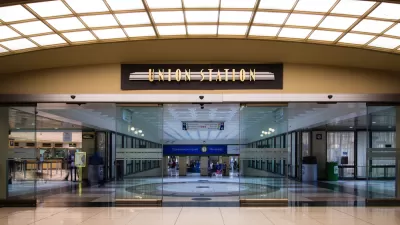20 years after its last makeover, and with successive grand renovation plans developed and abandoned in between, last week saw the release of a new master plan for America's third-busiest railroad terminal, reports Fran Spielman.
What makes this plan for increasing capacity and improving the passenger experience for the 120,000 arriving and departing passengers who ride 300 trains into and out of the station every weekday different from its predecessors? Mayor Rahm Emanuel's administration believes the solution resides in "lowering its sights to more realistic short-term projects with identified funding while still maintaining a list of medium- and long-term plans that could be done if the money is ever found," writes Spielman.
According to Jeff Sriver, the strategy in developing the plan was to, "take a step back from the grand, visionary ideas of the past that would have added new track and subway tunnels to bypass Union Station or, perhaps, relied on tearing down existing buildings and building a new structure in their place."
So while Los Angeles has asked teams of architects to "think big" about the future of its Union Station, Chicago has taken the opposite track.
"What are the steps we can take immediately to more realistically solve some of the urgent problems at Union Station? It's serving more people during peak periods than it ever has. It was once more for long-distance travelers. Now, most of the traffic is commuters. There's a lot of congestion on the platforms as well as in the station and getting out of the station. And the problems are only going to get worse," says Sriver.
FULL STORY: City Hall releases blueprint for upgrading Union Station

Planetizen Federal Action Tracker
A weekly monitor of how Trump’s orders and actions are impacting planners and planning in America.

Maui's Vacation Rental Debate Turns Ugly
Verbal attacks, misinformation campaigns and fistfights plague a high-stakes debate to convert thousands of vacation rentals into long-term housing.

San Francisco Suspends Traffic Calming Amidst Record Deaths
Citing “a challenging fiscal landscape,” the city will cease the program on the heels of 42 traffic deaths, including 24 pedestrians.

Defunct Pittsburgh Power Plant to Become Residential Tower
A decommissioned steam heat plant will be redeveloped into almost 100 affordable housing units.

Trump Prompts Restructuring of Transportation Research Board in “Unprecedented Overreach”
The TRB has eliminated more than half of its committees including those focused on climate, equity, and cities.

Amtrak Rolls Out New Orleans to Alabama “Mardi Gras” Train
The new service will operate morning and evening departures between Mobile and New Orleans.
Urban Design for Planners 1: Software Tools
This six-course series explores essential urban design concepts using open source software and equips planners with the tools they need to participate fully in the urban design process.
Planning for Universal Design
Learn the tools for implementing Universal Design in planning regulations.
Heyer Gruel & Associates PA
JM Goldson LLC
Custer County Colorado
City of Camden Redevelopment Agency
City of Astoria
Transportation Research & Education Center (TREC) at Portland State University
Jefferson Parish Government
Camden Redevelopment Agency
City of Claremont



























